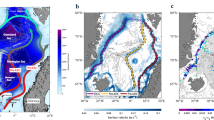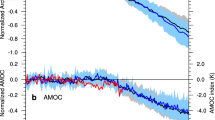Abstract
Recent observations suggest Antarctic Intermediate Water (AAIW) properties are changing. The impact of such variations is explored using idealised perturbation experiments with a coupled climate model, HadCM3. AAIW properties are altered between 10 and 20°S in the South Atlantic, maintaining constant potential density. The perturbed AAIW remains subsurface in the South Atlantic, but as it moves northwards, it surfaces and interacts with the atmosphere leading to density anomalies due to heat exchanges. For a cooler, fresher AAIW, there is a significant decrease in the mean North Atlantic sea surface temperature (SST), of up to 1°C, during years 51–100. In the North Atlantic Current region there are persistent cold anomalies from 2,000 m depth to the surface, and in the overlying atmosphere. Atmospheric surface pressure increases over the mid-latitude Atlantic, and precipitation decreases over northwest Africa and southwest Europe. Surface heat flux anomalies show that these impacts are caused by changes in the ocean rather than atmospheric forcing. The SST response is associated with significant changes in the Atlantic meridional overturning circulation (MOC). After 50 years there is a decrease in the MOC that persists for the remainder of the simulation, resulting from changes in the column-averaged density difference between 30°S and 60°N. Rather than showing a linear response, a warmer, saltier AAIW also leads to a decreased MOC strength for years 51–100 and resulting cooling in the North Atlantic. The non-linearity can be attributed to opposing density responses as the perturbed water masses interact with the atmosphere.














Similar content being viewed by others
References
Arbic B, Owens W (2001) Climatic warming of Atlantic intermediate waters. J Clim 14:4091–4108
Aoki S, Bindoff NL, Church JA (2005) Interdecadal water mass changes in the Southern Ocean between 30°E and 160°E. Geophys Res Lett 32:1–5
Banks HT, Bindoff NL (2003) Comparison of observed temperature and salinity changes in the Indo-Pacific with results from the coupled climate model HadCM3: processes and mechanisms. J Clim 16:156–166
Bindoff NL, McDougall TJ (2000) Decadal changes along an Indian Ocean section at 32°S and their interpretation. J Phys Oceanogr 30:1207–1222
Bryden HL, McDonagh EL, King BA (2003) Changes in ocean water mass properties: oscillations or trends? Sci Agric 300:2086–2088
Collins M, Tett SFB, Cooper C (2001) The internal climate variability of HadCM3, a version of the Hadley Centre coupled model without flux adjustments. Clim Dyn 17:61–81
Cooper C, Gordon C (2002) North Atlantic oceanic decadal variability in the Hadley Centre coupled model. J Clim 15:45–72
Cunningham SA, Kanzow T, Rayner D, Baringer MO, Johns WE, Marotzke J, Longworth HR, Grant EM, Hirschi JJ-M, Beal LM, Meinen CS, Bryden HL (2007) Temporal variability of the Atlantic meridional overturning circulation at 26.5°N. Science 317:935–938
Curry R, Dickson B, Yashayaev I (2003) A change in the freshwater balance of the Atlantic Ocean over the past four decades. Nature 426:826–829
Delworth T, Mann M (2000) Observed and simulated multidecadal variability in the Northern Hemisphere. Clim Dyn 16:661–676
Deser C, Blackmon M (1993) Surface climate variations over the North Atlantic Ocean during winter: 1900–1989. J Clim 6:1743–1753
Gordon C, Cooper C, Senior CA, Banks H, Gregory JM, Johns TC, Mitchell JFB, Wood RA (2000) The simulation of SST, sea ice extents and ocean heat transports in a version of the Hadley Centre coupled model without flux adjustments. Clim Dyn 16:147–168
Hátún H, Sandø AB, Drange H, Hansen B, Valdimarsson H (2005) Influence of the Atlantic subpolar gyre on the thermohaline circulation. Science 309:1841–1844
Holzer M, Primeau FW, Smethie WM Jr, Khatiwala S (2010) Where and how long ago was water in the western North Atlantic ventilated? Maximum entropy inversions of bottle data from WOCE line A20. J Geophys Res 115:1–26
Hughes T, Weaver A (1996) Sea surface temperature—evaporation feedback and the ocean’s thermohaline circulation. J Phys Oceanogr 26:644–654
Knight JR, Allan RJ, Folland CK, Vellinga M, Mann ME (2005) A signature of persistent natural thermohaline circulation cycles in observed climate. Geophys Res Lett 32:4
Levitus S, Antonov JI, Boyer TP (2005) Warming of the world ocean. Geophys Res Lett 32:L02604
McCartney MS (1977) Subantarctic mode water. In: Angel M (ed) A voyage of discovery, supplement to deep–sea research, George Deacon 70th anniversary volume. Pergamon, New York, pp 103–119
Meehl GA, Stocker TF, Collins WD, Friedlingstein P, Gaye AT, Gregory JM, Kitoh A, Knutti R, Murphy JM, Noda A, Raper SCB, Watterson IG, Weaver AJ, Zhao Z-C (2007) Global climate projections. In: Solomon AM, Qin D, Manning M, Chen Z, Marquis M, Averyt KB, Tignor M, Miller HL (eds) Climate change 2007: The physical science basis. Contribution of Working Group I to the Fourth Assessment Report of the Intergovernmental Panel on Climate Change. Cambridge University Press, Cambridge
Molinelli EJ (1981) The Antarctic influence on Antarctic Intermediate Water. J Mar Res 39:267–293
Pardaens AK, Banks HT, Gregory JM, Rowntree PR (2003) Freshwater transports in HadCM3. Clim Dyn 21:177–195
Piola AR, Gordon AL (1989) Intermediate waters in the southwest South Atlantic. Deep Sea Res 36:1–16
Saenko OA, Weaver AJ, Gregory JM (2003) On the link between the two modes of the ocean thermohaline circulation and the formation of global-scale water masses. J Clim 16:2797–2801
Seager R, Kushnir Y, Visbeck M, Naik N, Miller J, Krahmann G, Cullen H (2000) Causes of Atlantic Ocean climate variability between 1958 and 1998. J Clim 13:2845–2862
Sen Gupta A, England MH (2007) Evaluation of interior circulation in a high-resolution global ocean model. Part II: southern hemisphere intermediate, mode, and thermocline waters. J Phys Oceanogr 37:2612–2636
Sen Gupta A, Santoso A, Taschetto AS, Ummenhofer CC, Trevena J, England MH (2009) Projected changes to the southern hemisphere ocean and sea ice in the IPCC AR4 climate models. J Clim 22:3047–3078
Sijp WP, England MH (2008) The effect of a northward shift in the southern hemisphere westerlies on the global ocean. Prog Oceanogr 79:1–19
Sloyan BM, Kamenkovich IV (2007) Simulation of Subantarctic Mode and Antarctic Intermediate Waters in climate models. J Clim 20:5061–5080
Stark S, Wood RA, Banks HT (2006) Reevaluating the causes of observed changes in Indian Ocean water masses. J Clim 19:4075–4086
Suga T, Talley LD (1995) Antarctic Intermediate Water circulation in the tropical and subtropical South Atlantic. J Geophys Res 100:13441–13453
Sutton RT, Hodson DLR (2005) Atlantic Ocean forcing of North American and European summer climate. Science 309:115–118
Thorpe RB, Gregory JM, Johns TC, Wood RA, Mitchell JFB (2001) Mechanisms determining the Atlantic thermohaline circulation response to greenhouse gas forcing in a non-flux-adjusted coupled climate model. J Clim 14:3102–3116
Vellinga M, Wu PL (2004) Low-latitude freshwater influence on centennial variability of the Atlantic thermohaline circulation. J Clim 17:4498–4511
Wong APS, Bindoff NL, Church JA (1999) Large-scale freshening of intermediate waters in the Pacific and Indian oceans. Nature 400:440–443
Acknowledgments
Funding has been provided by a PhD studentship for the UK Natural Environment Research Council. This work has also been supported by a CASE studentship with the British Antarctic Survey. The research presented in this paper was carried out on the High Performance Computing Cluster supported by the Research Computing Service at the University of East Anglia. We would like to thank Ian Stevens for his technical support in the initial stages of this project, and two anonymous reviewers for their useful comments.
Author information
Authors and Affiliations
Corresponding author
Rights and permissions
About this article
Cite this article
Graham, J.A., Stevens, D.P., Heywood, K.J. et al. North Atlantic climate responses to perturbations in Antarctic Intermediate Water. Clim Dyn 37, 297–311 (2011). https://doi.org/10.1007/s00382-010-0981-1
Received:
Accepted:
Published:
Issue Date:
DOI: https://doi.org/10.1007/s00382-010-0981-1




